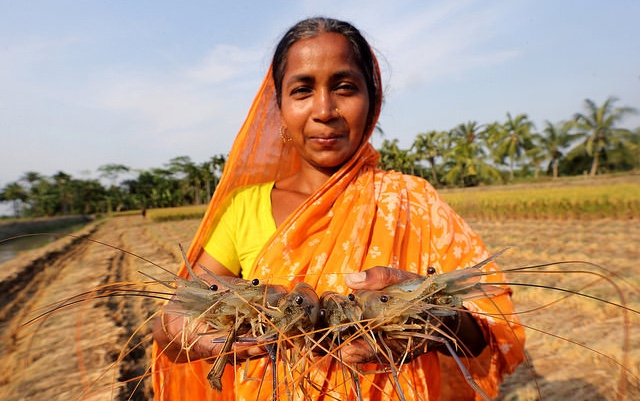Bangladesh is experiencing a quiet revolution in its domestic fish farming market that is having a direct impact on improving diets among both urban and rural poor households. Over the past three decades, Bangladesh’s farmed fish market grew by a dramatic 25 times in all aspects of the aquaculture industry, and the number of actors along the value chain has tripled in just the past decade alone.
Thanks to the rapid commercialization of the industry, fish farming in Bangladesh has transformed from a subsistence-oriented endeavor by small-scale farmers into a robust sector of the economy. About 75 percent of fish farming households now sell fish. Farmers have raised yields, and the cost of farmed fish has gone down, contributing to food security.
Most surprising, perhaps, is the extent of development across all sectors, not just in production but also in many off-farm segments, such as rural and urban traders, input dealers and feed mills. The rapid increase in mainly small and medium actors has produced a more competitive environment that has pushed the adoption of new technologies, which has increased productivity. These changes have greatly benefited poor and low-income consumers who can actively participate in the boom.
The rapid growth has been spawned by increased demand; improvements in technology, communications, and infrastructure; and small investments by millions of farm households and small and medium enterprises. Very little change was brought about by NGO or government action, although the government did play an important role in the early stages in the 1980s with infrastructure investment (such as investment in fish seed production, electricity, and roads), a pro-business outlook, and a laissez-faire approach to land use and crop choice.
What do these rapid changes in fish farming mean for the average consumer? Like other Asian countries where the great majority of fish farmed is sold and consumed domestically, 94 percent of aquaculture production in Bangladesh is destined for domestic consumption. About 42 percent of that production is consumed in urban areas, and that share of the market is growing fast. Urban dwellers consume 31 percent more fish per capita compared with rural consumers.
Just over a decade ago, rural fish farmers usually sold their fish to local traders; now they are selling two-thirds of their product to large wholesalers based in towns and cities. The fish available at market has also changed. Carp is still the predominant fish consumed, but the production of tilapia and pangasius (a type of catfish) has risen, adding diversity to the fish supply available in markets.
Rapid increases in urban consumption of farmed fish in Bangladesh mirror the trend that is taking place throughout Asia. This trend is particularly significant for Bangladesh, where fish is the most important food, after rice, in terms of share of the food budget. As aquaculture has become an important driver of the Bangladeshi economy, both rural and urban poor households have improved their diets by consuming more protein and micronutrients from another source.
Rice is here to stay as Bangladesh’s staple food, yet this shift towards greater fish consumption indicates that rice- dominated diets in Bangladesh are gradually diversifying, and may help turn the tide on the country’s persistent nutritional challenges, such as micronutrient deficiencies.
Ricardo Hernandez is a Research Coordinator and Julie Ghostlaw is a Project Coordinator with IFPRI’s Bangladesh Policy Research and Strategy Support Program. This post first appeared on the Thomson Reuters Foundation News site.







